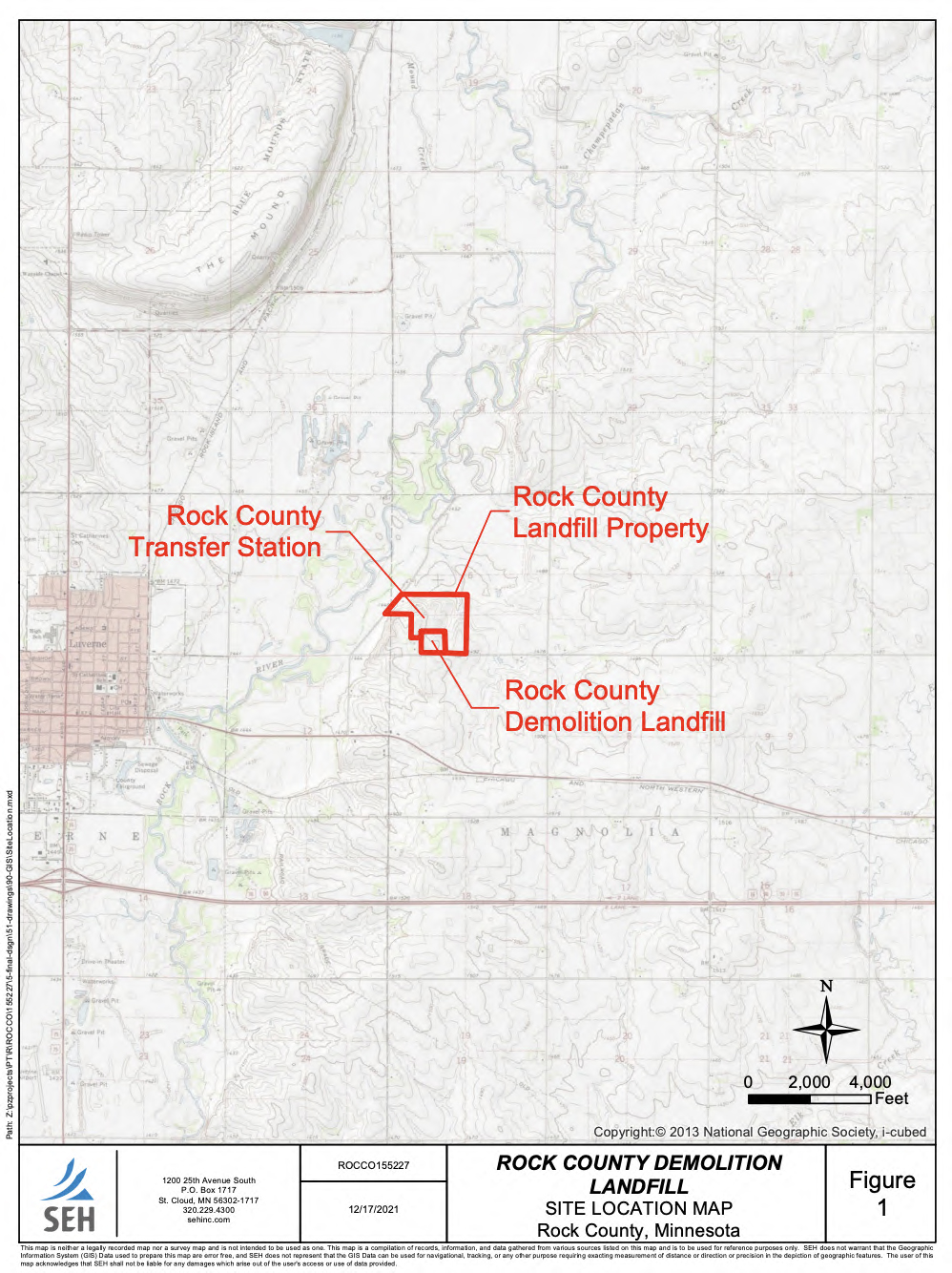 ,
,  ,
,  ,
, 
A long-term study of Rock County’s demolition landfill predicts the eight-acre construction and building debris disposal site will be at capacity by 2027.
Eric Hartman, the county’s Land Management Office director, presented the 39-page feasibility study to commissioners at their Sept. 6 meeting.
“We have about five to 5 1/2 years at present fill levels — if we continue as we have,” Hartman said.
“This doesn’t take into account if we have a catastrophic event like a tornado … (which) could wreak havoc with what we have capacity-wise.”
On average the demo landfill, located three miles east of Luverne, receives 12,981 cubic yards of debris annually.
It’s placed in a large pile where it is compacted and mounded in dirt with a 5:1 slope.
The study, conducted by longtime landfill consultants SEH of St. Cloud, outlines four possible options.
They suggest commissioners decide a course within the next 12 months due to the length of time it takes to receive state permits.
Do nothing, close
landfill in five years
The study indicated if commissioners do nothing and close the facility once capacity is reached, future debris will need to be trucked elsewhere.
The nearest demo landfill to Rock County is 25 miles away in Nobles County. The next is in Lincoln County, and both are reaching capacities in an estimated eight years.
“The whole state is in the same predicament,” Hartman said.
Local municipal solid waste (MSW) is already transported to Lyon County, which occurred in 1993 when the MSW landfill in Rock County was closed.
In an existing agreement, when MSW is delivered by truck to Lyon County, the Rock County truck returns with demo debris and deposits it in the local landfill in a cost-saving measure.
The study indicated that changing which materials are accepted or limiting the use of the landfill to just county residents would extend the landfill’s lifespan.
Increase slope of current debris pile
A variance to Rock County’s 10-year landfill permit would be needed for a vertical expansion.
The variance would allow Rock County to increase the height of the current debris pile.
Instead of a 5:1 slope, the proposal increases the slope to 4:1.
The Minnesota Pollution Control Agency (MPCA) issues the permit and would need to OK the change that would extend the landfill’s capacity to 10 years.
The vertical expansion takes place on the same eight-acre landfill footprint.
“One of the downfalls to a steeper slope is that we will be susceptible to runoff during heavy rainfall,” Hartman said.
Boron and manganese are typically found in groundwater testing. Elevated levels are attributed to the leaching of the chemicals from building debris, the study reported.
Mark Sehr, the county’s engineer, said samples from local test wells and runoff from a nearby creek are completed quarterly and haven’t showed chemical levels exceeding state standards.
Cost associated with a vertical increase is $750,000 to $1 million.
Expand existing landfill eastward
The study indicated that the county owns an additional 14 acres, located east of the current demo landfill.
The lateral expansion would increase capacity to 44 years and cover an additional seven acres, adjacent to the existing site.
When the state took over the nearby MSW landfill in 1993 under the state’s Closed Landfill Program, the county granted the state perpetual restrictive easements when the state took over monitoring the former MSW site and fund a potential cleanup.
A leachate collection system may also be necessary.
The system allows any precipitation to collect stormwater and/or stormwater that comes in contact with the debris. The leachate would then be rendered at a municipal treatment plant.
Estimated costs put the expansion at $2.5 to $3.5 million, with additional ongoing operational costs due to the leachate treatment.
“It is a nice long-term solution,” said County Administrator Kyle Oldre. “But it’s got its own challenges.”
Develop a
new demo landfill
The study indicated MPCA’s history issuing permits for new demo landfills or expansions as few or none at all.
The study estimates a five-year wait for any permit issuance. Rock County’s demo landfill permit expires in 2027.
Since 2002, Hartman and Sehr have talked with MPCA officials about how the landfill is quickly coming to capacity.
Hartman said it’s uncertain if a potential synthetic liner is necessary or what other requirements are needed, if any.
“It’s been a little challenging trying to move forward with plans because the state is operating under a set of rules regarding demolition waste that they have talked about updating for the last 6-8 years,” Hartman said.
The study put no estimated costs to a new landfill and indicated that this was not a recommended option for Rock County.
“Nobody wants this in their backyard,” Oldre said.
Currently the transfer of local municipal waste is brought to a facility at the landfill site. If a new landfill site is establish, the garbage collection would also be moved.
Landfill origin
dates back to 1995
The demolition landfill in Rock County opened in 1995. At the time engineers set a lifespan of 36.5 years based on use.
At 27 years, the demo landfill is reaching capacity faster than expected.
Commissioners encouraged staff to work at a solution, which may include working with the other regional counties and/or the Association of Minnesota Counties. Together with legislators and state officials, a solution can be found.
“We are not looking for a fight. We just want guidance and timely responses,” said Commissioner Jody Reisch.
“We want to work with them and do what’s right for the environment and citizens, but I don’t want to be four to five years from now and looking at a $3, $4 or $5 million bond.”


